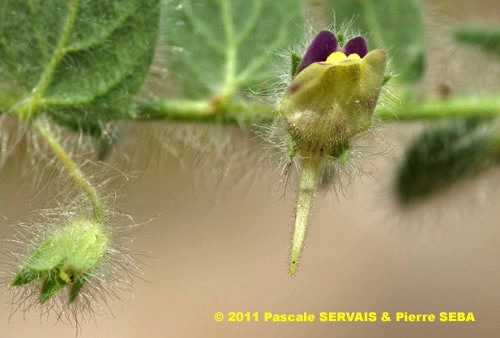
Kickxia elatine subsp. sieberi (Arcang.) Hayek
Fam. : Scrophulariaceae
© Pascale SERVAIS & Pierre SEBA, 2018. Tilo Botanica: Flore de Tilos et du Dodécanèse / Flora of Tilos and of the Dodecanese
English translation by Brenda Bradbury, Howard Bradbury and Stéphane Léonard
Plante herbacée, hermaphrodite, à tiges étalées à rampantes, couvertes de poils glanduleux.
Feuilles alternes, simples, ovales à sagittées, de 10 à 40 mm de long, pointues, à pétiole court, à longs poils blancs.
Fleurs à symétrie bilatérale, jaunes et mauves, de 7 à 15 mm de long (avec l’éperon), solitaires à l’aisselle des feuilles, portées par un pédoncule de 5 à 12 mm de long, velu sur toute sa longueur, plus court que la feuille sous-jacente. Corolle à 2 lèvres rapprochées, la lèvre inférieure trilobée, jaune, la lèvre supérieure bilobée, violette. Éperon droit, jaunâtre, de 5 mm de long. Calice à 5 sépales libres, verts, unis, pointus, velus. Ovaire supère.
Fruits, capsules sphériques, vertes, de 3 à 4 mm de diamètre, à poils courts. Graines couvertes de crêtes sinueuses et épaisses.
___________________________
Plant herbaceous, hermaphrodite. Stems spread out to trailing, covered in glandulous hairs.
Leaves alternate, simple, ovate to sagittate, from 10 to 40 mm long, pointed, with a short petiole, with long white hairs.
Flowers bilaterally symmetrical, yellow and mauve, from 7 to 15 mm long (with the spur), solitary at the axil of the leaves, carried by a peduncle from 5 to 12 mm long, very hairy on all its length, shorter than the underlying leaf. Corolla with 2 lips brought closer, the lower lip three-lobed, yellow, the upper lip two-lobed, violet. Spur straight, yellowish, 5 mm long. Calyx with 5 free, green, self-coloured, pointed, very hairy sepals. Ovary superior.
Fruits, spherical, green capsules, from 3 to 4 mm in diameter, with short hairs. Seeds covered in thick and sinuous crests.
Descripteurs / Identifying features
1
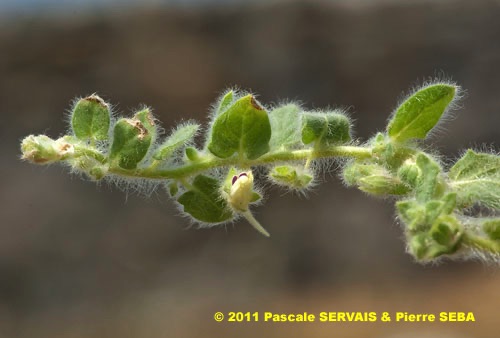
2
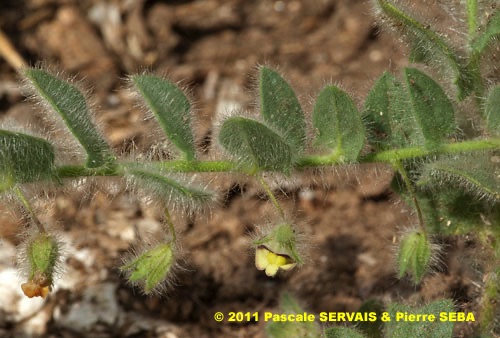
3
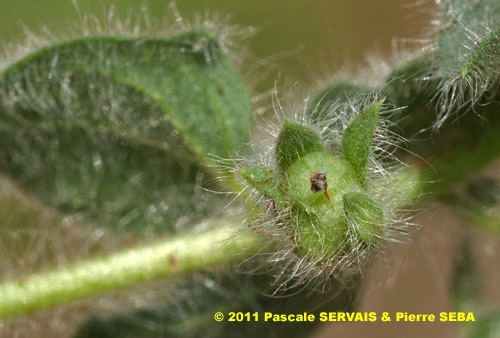
4
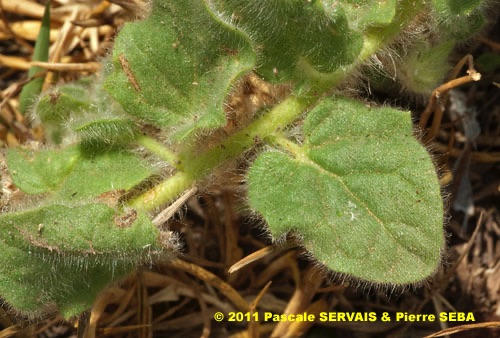
5
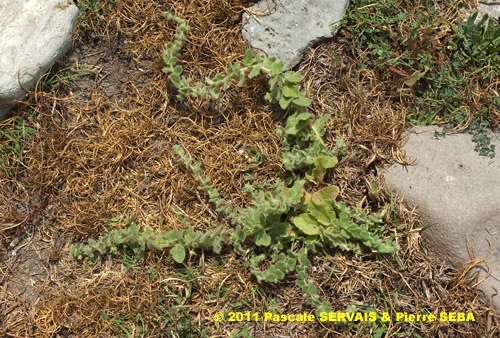
6
Étymologie / Etymology :
Kickxia : nom donné en l’honneur de Jean Kickx (1775-1831), né à
Bruxelles, professeur de botanique, de pharmacie et de minéralogie,
auteur de l’ouvrage “Flora Bruxellensis ” (1812).
Elatine : emprunt du grec ancien ἐλάτη, -ης (nom) = le sapin,
la spathe qui enveloppe le fruit du palmier.
Sieberi : nom donné en l’honneur de Franz Wilhelm Sieber (1789-1844),
botaniste pragois qui étudia la flore des Alpes.
Kickxia : name given in honour of Jean Kickx (1775-1831), born
in Brussels, professor of botany, pharmacy and mineralogy, author
of “Flora Bruxellensis ” (1812).
Elatine : borrowed from Classical Greek ἐλάτη, -ης (noun) = fir tree,
spathe surrounding the fruit of the palm tree.
Sieberi : name given in honour of Franz Wilhelm Sieber (1789-1844),
botanist from Prague who studied the flora of the Alps.
Synonymes / Synonyms :
Kickxia elatine subsp. crinita (Mabille) Greuter
Kickxia lasiopoda (Vis.) Fritsch
Kickxia sieberi (Rchb.) Allan
Linaria bombycina Boiss. & Blanche
Linaria crinita Mabille
Linaria elatine subsp. lasiopoda (Vis.) Arcang.
Linaria elatine subsp. sieberi Arcang.
Linaria prestandreae Tineo
Linaria sieberi Rchb.
Linaria sieberi Rchb. ex Rouy
Linaria sieberi var. prestandrae (Tineo) Rouy
Noms vernaculaires / Common names :
Noms français / French names :
Élatinée — Kickxia élatine — Linaire auriculée —
Linaire chevelue — Linaire de Sieber — Linaire élatine —
Muflier auriculé — Velvote — Volvote.
Noms anglais / English names :
Elatine-toadflax — Fluellen — Halbert-leaved-toadflax —
Sharp-leaved fluellen — Sharpleaf cancerwort.
Noms allemands / German names :
Echtes Tännelkraut — Echtes Tännelleinkraut —
Pfeilblättriges Leinkraut — Pfeilblättriges Schlangenmaul —
Spießblättriges Leinkraut — Spießleinkraut —
Spitzblättriges Tännelkraut — Wilder-Flachs.
Noms italiens / Italian names :
Cencio minore — Cencio molle minore — Elatine — Soldino.
Habitat :
Cultures - Lieux pierreux - Lieux incultes - Lieux humides, mares.
Cultivated places - Stony places - Waste ground -
Damp places, ponds.
Île / Island :
Tilos.
Hauteur / Height range :
De 5 cm à 20 cm.
From 5 cm to 20 cm.
Floraison / Flowering time :
De mai à novembre.
From May to November.
Groupe / Classification :
Dicotylédones.
Dicotyledons.
Pérennité / Lifespan :
Annuelle.
Annual.
Description :
Clés dichotomiques et descripteurs distinctifs des 2 espèces / Dichotomous keys and distinctive identifying features of the 2 species
Photo 1 :
Localisation / Location : Tilos, Megalochorio, Aghios Andonis
Date : 30/05/2011
GPS : Lat. 36,45850° N / Long. 27,33476° E / Alt. 4 m
Type : Photographie numérique / Digital Photograph (10 mégapixels)
Photo 2 :
Localisation / Location : Tilos, Megalochorio, Aghios Andonis
Date : 30/05/2011
GPS : Lat. 36,45850° N / Long. 27,33476° E / Alt. 4 m
Type : Photographie numérique / Digital Photograph (10 mégapixels)
Photo 3 :
Localisation / Location : Tilos, Megalochorio, Aghios Andonis
Date : 30/05/2011
GPS : Lat. 36,45850° N / Long. 27,33476° E / Alt. 4 m
Type : Photographie numérique / Digital Photograph (10 mégapixels)
Photo 4 :
Localisation / Location : Tilos, Megalochorio, Aghios Andonis
Date : 30/05/2011
GPS : Lat. 36,45850° N / Long. 27,33476° E / Alt. 4 m
Type : Photographie numérique / Digital Photograph (10 mégapixels)
Photo 5 :
Localisation / Location : Tilos, Megalochorio, Aghios Andonis
Date : 30/05/2011
GPS : Lat. 36,45826° N / Long. 27,33364° E / Alt. 2 m
Type : Photographie numérique / Digital Photograph (10 mégapixels)
Photo 6 :
Localisation / Location : Tilos, Megalochorio, Aghios Andonis
Date : 30/05/2011
GPS : Lat. 36,45826° N / Long. 27,33364° E / Alt. 2 m
Type : Photographie numérique / Digital Photograph (10 mégapixels)

Google Maps
Google Maps
Google Maps
Google Maps
Google Maps
Google Maps